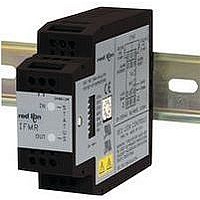IFMR0066 Red Lion Controls, IFMR0066 Datasheet - Page 6

IFMR0066
Manufacturer Part Number
IFMR0066
Description
Isolation Amplifier
Manufacturer
Red Lion Controls
Type
Speedr
Datasheet
1.IFMR0036.pdf
(8 pages)
Specifications of IFMR0066
Width
3.12"
Signal Input Type
Selectable Current Or Voltage
Configuration Setup
DIP Switch
Supply Voltage Max
250VAC
Iso-amp Mounting Type
DIN Rail
Display Alarm Type
Relay
Input Accuracy
± 0.1% Of FS
Application
The IFMR utilizes a seven position DIP switch, a rotary switch, a pushbutton and two indication LEDs to accomplish input circuit configuration, operational parameter set-up, input signal, and relay status indication
Brand/series
IFMR Series
Contact Form
SPDT
Current Rating
5 A
Dimensions
27.5mmW×4.2mmH×79.2mmD
Display Type
LED
Input Type
Analog
Mounting Type
DIN Rail
Output Type
Relay
Power, Rating
5.5 VA
Primary Type
Controller
Sensor, Input
12 VDC
Standards
cURus, CE
Temperature, Operating
0 to +50 °C
Termination
Screw
Voltage, Rating
85 to 250 VAC
Voltage, Supply
85-250 VAC
Lead Free Status / RoHS Status
Lead free / RoHS Compliant
For Use With
Sensors/Switches/TTL
3.0 Set Trip Frequency Using The Rotary Switch
4.0 Set Minimum Response Time
BLINKS
OUTPUT
BLINKS
OUTPUT
GREEN
GREEN
INPUT
INPUT
LED
LED
RED
OFF
RED
LED
OFF
LED
METHOD IF INPUT
SIGNAL IS NOT
O U
O U
IN
IN
T
T
ALTERNATIVE
Step 3.2
Step 3.5
Step 4.2
AVAILABLE
Step 3.4
Step 4.3
Step 4.4
PUSH-BUTTON
PUSH-BUTTON
ROTARY
SWITCH
ROTARY
SWITCH
Setting ‘2’
4
Selected
4
Step 3.1
Step 4.1
Setting ‘2’
0
5
5
5
Selected
0
5
6
6
7
7
3.1 Place DIP switch 4 to the ON position and DIP switches 5, 6, and 7 as shown.
3.2 The Green input LED blinks the existing Trip Frequency setting, pauses and repeats. Six full
3.3 Determine the Trip Frequency and record in the space provided below.
3.4 Press the push-button. The Green input LED blinks rapidly. Trip Frequency setting is now
3.5 Turn the rotary switch to the first selected numerical value. Press the push-button. The Green
3.6 Turn the rotary switch to the second selected numerical value. Press the push-button. The
3.7 Repeat Step 3.6 three more times then go to Step 3.8. This enters a total of five of the required
3.8 Turn the rotary switch to the selected numerical value for resolution requirement. Press the
*
4.1 Place DIP switch 4 to the ON position and DIP switches 5, 6, and 7 as shown.
4.2 The Green input LED blinks the existing Minimum Response Time setting (see following list),
Note: Minimum Response Times do not include the relay’s operate response time of 5 msec., or
4.3 Press the push-button. The Green input LED blinks rapidly. Minimum Response Time setting
4.4 Turn the rotary switch to the selected numerical value for Minimum Response Time desired
4.5 Press the push-button. The Green input LED blinks the value entered, pauses, and repeats the
*
Section complete; place DIP switch 4 to the down position for normal operation, or change DIP
Section complete; place DIP switch 4 to the down position for normal operation, or change DIP
If the existing Trip Frequency setting is your desired requirement, this section is complete
Otherwise, continue with Step 3.3.
If the new Trip Frequency setting is acceptable, this section is complete
If the new Trip Frequency setting is not the desired setting, repeat Steps 3.4, through 3.8.
through 3.8.
switches 5, 6, and 7 for the next Configuration Section.
pauses and repeats.
the release response time of 3 msec.
If the new Minimum Response Time setting is acceptable, this section is complete
and 4.5.
and 4.5.
switches 5, 6, and 7 for the next Configuration Section.
If the new Minimum Response Time setting is not the desired setting, repeat Steps 4.3, 4.4,
If the Red relay LED blinks, the rotary switch numerical value is invalid. Repeat Steps 4.4
If the Red relay LED blinks, the numerical value entered is invalid. Repeat Steps 3.3
9
0
0
accessed.
input LED continues to blink rapidly. First of six numerical digits is entered.
Green input LED continues to blink rapidly. Second of six numerical digits is entered.
six numerical digits.
push-button. The Green input LED blinks the new Trip Frequency setting (as described in Step
2.2), pauses, and repeats the value.
is now accessed.
(see list in Step 4.2).
new setting.
digits of numerical information blink with a 2 sec. pause between digits and a 4 sec. pause at
the end, before repeating. The first five digits are the existing Trip Frequency magnitude. The
sixth digit is the frequency resolution (the number of digits to the right of the decimal point).
Example: 95.5 Hz
Ferrite Suppression Cores for signal and control cables:
5 • 5
9
0
Setting
First 5 of 6 digits
Trip Frequency
5 • 5
0
1
2
3
4
9
6
0
5 • 5
Time
5 msec
10 msec
20 msec
50 msec
100 msec
0
0
3
2
1
Resolution
6th digit
Setting
5
6
7
8
9
Time
200 msec
500 msec
1 sec
5 sec (not valid for trip frequency > 3906 Hz)
10 sec (not valid for trip frequency > 3906 Hz)
1
Example: 15,500 Hz
5
5
0
0 •
*
.
0
*
.
*
.








